It was said that a toss of a coin chose Rawfolds mill as the target for the Luddite attack in 1812; if the coin had landed the other way , the attack would have been on Ottiwells mill, property of Mr William Horsefall, situated in the village of Marsden, approximately seven or eight miles from Huddersfield . like his associate William Cartwright, he had fortified Ottiwells Mill, as Cartwright had fortified Rawfolds Mill. He had built a wall with firing slits through outside his mill, and mounted small cannon behind. William Horsefall was well known for despising the luddites , and was said to have claimed that he would happily ride up to his saddle girths in luddite blood , the local children, on seeing him riding past would often run alongside chanting ” I’m general Ludd , I’m general Ludd ” . Until William Horsefall quickly lost his temper and chased them off with his horse whip. Below is an etching of Ottiwells House showing the fortifications that William Horsefall had erected to protect his mill ( click to enlarge)

There is also a later photograph taken from roundabout the same spot, showing the wall, with mill(?) buildings behind it.
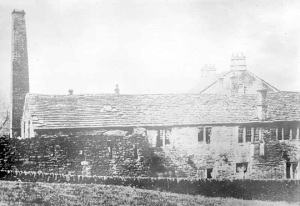
Ottiwells House , where William Horsefall lived was demolished in the late 19th or very early 20th century, it stood at the junction of Mount Road and Binn Road. – here is a Google earth shot – arrow showing the site of house.
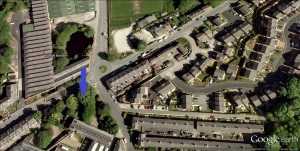
The place where the rather grand house that William Horsfall lived in is now a small wooded area , with the now disused Bank Bottom Mills behind , and to the left.

William Horsefall was not a bad man, like his associate William Cartwright, he was a man of his time, he had similar views to Cartwright on using machinery, and laying off men when the machines took their work, and after all he did employ nearly 400 men in his mill. The shearing frames that were taking the croppers jobs were of course made in same village , less than half a mile away, so could be delivered within hours of being made – no chance of them being broken by the luddites en route. William Horsefall’s willingness to replace men with machinery, his obvious wealth, strong opinions and outspoken hatred of the luddites, made him,and his factory, a very likely target of the luddites.
The luddites were a collection of very desperate people, almost like a small guerilla army targeting the machinery, that they saw as taking their work, so starving their families. The majority of the population of course were in a similar position, so covertly supported the luddite movement, without being part of it. The reality of the situation was that Napoleon Bonaparte was a major cause of the problems, his empire having control over most of Europe, barring trade with Britain, causing a great economic depression in Britain,plus several years of poor harvests from the farms with the manufacturing areas bearing the brunt of the slump. The British authorities feared a revolution, and even investigated if Napoleon was sending money to fund the luddites; the investigation found no evidence of this whatsoever, but rumours were rife.
” When beef and mutton and other meat,
were almost as dear as money to eat;
and farmers reaped golden harvests of wheat
At lord knows what per quarter. “ – Hood
The luddites were activists without a political voice, and the only way that they felt they could draw the attention of the government to the plight of the common people, was by their machine breaking actions – this became the only way for the luddites who were active in first quarter of the 19th century.
Following the death of two of their men involved in the failed attack on Rawfolds mill, the luddites suddenly became to be seen as a fallible force, rather than a force that appeared out of nowhere , and carried out their task, before disappearing back into the night. This did not sit very well with the luddite movement in West Yorkshire, so a decision was made to change tactics. One of the leaders of the luddites in the area was a rather fiery young man called George Mellor , he was a cropper working for his step father (Mr Wood) at John Woods cropping shop situated at the side of the river Colne at Longroyd Bridge , near Huddersfield. Longroyd Bridge is only about half a mile from Huddersfield town centre, down the road now called Manchester Road. The croppers at this time had the reputation of being a wild and reckless body of men.
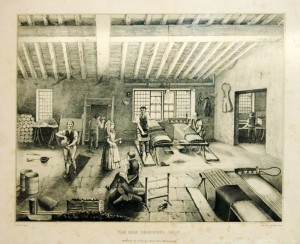
Below are a couple of pictures of the building that was John Woods cropping shop , prior to demolition.


The crosses painted on the buildings are probably marking them for demolition. The empty building was used for storing lumber in the late 19th century, long after the cropping shop had closed down .
In the spring of 1812, following the failed attack on Rawfolds mill, the young George Mellor, being only twenty one or twenty two years old, was working in his step father’s cropping shop, putting the next plan together – the murder of one of the masters ( mill owners) ; namely William Horsefall of Ottiwells in Marsden. William Horsefall had openly spoken about the luddites – almost goading them, by referring to them as cowards, and stating that “He would know how to deal with them ” and that he would ” Gladly ride up to his saddle girths in luddite blood”. William Horsefall’s fellow business men and friends had often warned him to not be so outspoken, but to no avail because that was the type of man that he was, insamuch that he said what he thought, and he thought what he said, and he wasn’t going to be silenced by anyone. George Mellor had become , in effect, an unelected leader of the luddites in the West Riding of Yorkshire (certainly in the Huddersfield area) – He knew how to speak to his fellow ludds, he knew how to get them “fired up” , and they also feared getting on the wrong side of him as there was always an underlying threat of harm to those who did not follow. Much of the plotting was done in John Woods cropping shop – though John wood himself, being Mellor’s step father, would later deny having had any knowledge of what was happening there. The version of events I am giving is basically similar to the “official version ” of events, as other versions do exist – including conspiracy theory versions, most of my information is taken from statements given in court, contemporary newspaper reports , and a pamphlet printed some forty years later in Huddersfield. George Mellor certainly felt sore – almost embarrassed , after the failed attack on Rawfolds mill, he was also feeling hurt over the death of two of his men; clear thinking was clouded by thoughts of vengeance running through his head – and vengeance he would get. – It had become personal. The week following the march and failed assault on Rawfolds mill, John Woods cropping shop became a hive of activity for the luddites, with a quantity of gunpowder, being delivered, then concealed, and arrangements for pistols to be borrowed or delivered for the next mission. George Mellor had already arranged to borrow back a pistol that he had once owned then sold on, it was a large bore Russian horse or cavalry pistol, with a barrel over a foot long.

It was Tuesday the 28th of April 1812 , William Horsefall had made his way from Marsden to Huddersfield, on horseback for the weekly market, much of the market business involved the textiles made locally. The route from Marsden to Huddersfield at that time came down the road now known as Blackmoorfoot Road through open land which later became a built up suburb of Huddersfield called Crosland Moor; the current main route now runs down the A62 Manchester Road which did not exist as such in 1812. As a rule the old routes are usually the high roads, and the newer routes the low roads, and the A62 Manchester Road is by comparison the low road from Marsden. In John Woods cropping shop George Mellor was working alongside a young man Thomas Smith , who was also about only twenty one years of age, William Thorpe was there and Benjamin Walker , allegedly in a different room. William Thorpe was not a regular worker at john Woods, but worked in a nearby “finishing shop”[cloth finishing] called Fishers – if and when they had any work for him. Much of the my information comes from evidence given in court by Benjamin Walker who turned kings evidence to save his own skin, so we must bare this in mind when reading his evidence, as he was obviously trying to make out that he was oblivious to a lot of what was going on around him. Late in the afternoon George Mellor called Benjamin Walker into the same room and gave him a pistol, William Thorpe was also armed, and Mellor had his pistol which he had loaded when he collected – he put in a double charge of powder, a ball as large as a musket ball, two slugs that he had made by flattening pistol balls with a hammer, then a second ball, then rammed down with the rod. The man who had lent Mellor the pistol had said incredulously “ You do not mean to fire that pistol I hope.” To which Mellor replied “Yes, I mean to do for Horsefall – Will you go with us? The witness (who had lent him the pistol) declined the invitation. About four o’clock George Mellor told Thomas Smith and Benjamin Walker to go up the Marsden Road ( now Blackmoorfoot road) and to wait in Mr Radcliffes plantation . Ironically Mr Radcliffe was a local magistrate, who was trying to find out the identity of the luddites so they could be captured and tried for their crimes. Mr Joseph Radcliffe (later sir Joseph Radcliffe) was of course a member of the landed gentry as you can see from his portrait – he was a long way from starving.
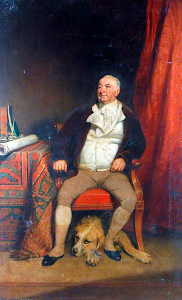
Mr Radcliffe lived in a grand house – Milnsbridge House – the shell of the house is still standing, but the majority of the interior, was ripped out years ago and the house is now home to a light engineering firm.


The pictures above are from roundabout the turn of the twentieth century, long after the Radcliffes had sold the Milnsbridge estate in 1824. It is not possible to take a similar shot of the house as it is now built up around , but over 200 years later it is still being used as a workshop to an engineering firm.

Thomas Smith and Benjamin Walker were making their way to Mr Radcliffes plantation, when Walker told the court that he said to Smith that they should turn back and implore George Mellor to not carry out this deed, to which Smith replied that he would have a word with Mellor when Mellor and William Thorpe got to the plantation. Mellor and Thorpe arrived at the plantation, a short while after Smith and Walker; Mellor said that he and Thorpe would wait at the bottom corner of the plantation, and Smith and Walker should wait at the top corner, Mellor said that when he saw William Horsefall approaching he would give a whistle, for them to get ready to fire – Mellor and Thorpe would fire first, and if they missed, then Smith and walker should fire from where they were. At this point Smith went to Mellor and asked him to call off the ambush, but Mellor told Smith that if either he or Walker walked away he ( Mellor) would shoot them as soon as look at them. Smith went back to Walker and told him what Mellor had said, so Smith and Walker decided they had to stay. ( This was Walkers testimony in court – so we do not know how much of this conversation is true or fabrication.) William Horsefall carried out his business deals in Huddersfield, as he normally did on market day, maybe visiting the Cloth Hall (demolished 1929/30), and finishing in the (old) George Hotel.
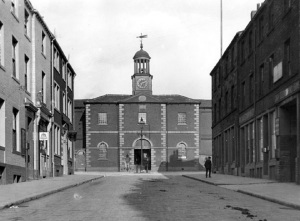
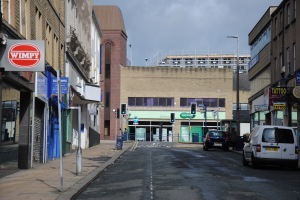
Mr Horsefall finished his business and set off from the George hotel at about 5 pm due to sundown being about 7pm at that time of year, and not wishing to travel in the dark.
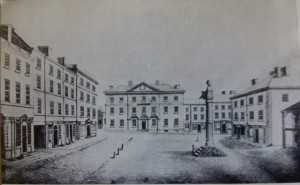
The George Hotel was taken down in the mid 19th century when John William street was laid to the new railway station that was being built in Huddersfield; a new George Hotel was built just outside the new station. Mr Horsefall made his way ( on horseback ) to Longroyd Bridge , passing close by John Woods cropping shop, and up the Marsden road (now called Blackmoorfoot Road ). As was his usual practice on market day , he stopped at an inn on the road known as “The warrener” or “The warrenhouse”, he stayed on his horse and had a stirrup cup of rum and water, and seeing two of his former employees there, John and Joseph Sykes he bought them a glass of gin and water each. Roundabout six o’clock he set off from the inn up the road towards the plantation. Although the road went through open land , it could still be quite busy with people traveling to Huddersfield and back especially on market day, and about 150 yards behind Mr Horsefall a man called Mr Parr, who was a farmer , following the same route. When Mr Horsefall was about twenty yards from the plantation Mr Parr heard the crack of a pistol shot,then a second shot and he saw the movement of people in the wooded plantation, he saw William Horsefall slump forward onto the neck of his horse, then drag himself back up by the horses mane, then cry “MURDER ! ” . Mr Parr rode forward very quickly and seeing a man climbing onto the plantation wall – as if to carry on the attack shouted out “What ! art thou not contented yet ? ” . The man presumably not seeing Mr Parr till that point, dropped back behind the wall and disappeared into the wooded plantation. Mr Parr on reaching William Horsefall saw blood oozing from his side and William Horsefall said “Good man, you are a stranger to me, but pray, ride to Mr Horsefalls house [ meaning his brother the rev Abraham Horsefall ] and get assistance. – I am shot ! ” Mr Parr who was now supporting William Horsefall in his arms as he was going faint and beginning to fall said ” Are you Mr Horsefall of Marsden ? ” “I am ” he replied as he fell from his horse with blood now spurting from his side. The four men in the plantation quickly made their way to the back of the plantation, clambered over into the fields behind and quickly made their way towards woodland known as Dungeon Wood. Part of Dungeon wood still exists today, and Beaumont Park lies in the former Dungeon wood
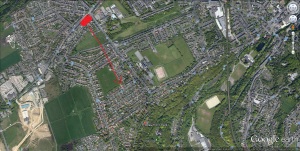
The Google earth picture above shows the approximate location of the plantation, and the arrow shows the approximate route of the escaping luddites.
The plantation is long gone, and houses now stand there, but a street name commemorates the event.

Not many yards away from here William Horsefall was shot from his horse. A sturdy row of stone built houses now occupy the site of the plantation – the houses on the right of the picture below.

Here below is a contemporary artist’s impression of the event – a completely inaccurate image drawn by someone who had almost certainly never visited the scene – William Horsefall was attacked from his left-hand side not his right – but I will show the image anyway.
Mr Parr looking up the road , saw two boys , brothers, who had been given the task of clearing dung from the road ( yes honestly) by their father. He called the boys down , to sit with Mr Horsefall who he had laid at the road side , while he rode down the road to fetch help. Another man, Joseph Bannister, a clothier, encountered Mr Parr galloping down the road, Mr Parr quickly informed him of the situation, so he hurried up to Mr Horsefall ” Lying at the side of the road , very bloody” The two boys were sent down to the Warrenhouse inn to fetch a cart to transport the wounded Mr Horsefall back down to the inn. Mr Horsefall, bleeding profusely was taken back down to the inn ( about a quarter of a mile from the plantation) and put in bed in the ” best room” , doctors and surgeons were sent for. Dr Houghton arrived at the inn between 8 and 9 o’clock, being the second medical practitioner to try and assist Mr Horsefall, on examining him he found two serious wounds on the upper part of the left thigh, and five other wounds on different parts of the lower body and groin area, a large musket ball had been extracted prior to his arrival, and he extracted another large ball that had got as far as his Right thigh – near the hip joint, he described the ball as having entered at the left hand side , and he suspected, damaged the femoral artery. William Horsefall was of course in a bad way, but about four o’clock the following day he seemed a little brighter – he looked turned to Mister Houghton and said “ what is your opinion doctor ? ” to which Dr Houghton had to honestly reply ” Indeed Mr Horsefall, I consider you in a dangerous state “ William Horsefall sighed then replied ” These are awful times, doctor .” William Horsefall’s determination to live was slowly ebbing away , and he died thirty six hours after being shot. The Warrenhouse no longer exists , in fact when the ” new” A62 Manchester road was built ( The low road to Marsden), in about 1820 – only six years after the shooting a new Warren house was built on the new road and the license and business transfered. – like a lot of pubs this has closed , but the building is still in use.. We do know roughly where the Warren house was – about 400 yards down from the plantation on the current Blackmoorfoot road and I have a description written by a local history writer some fifty years or so later.
“An old cropper, who has lived close to the inn all his life, told us that he well remembered the wounded man being brought to the door in a cart, and saw the blood run down his clothes to the ground as they carried him in. The old hostelry exists no longer as a separate building: a co-operative store has been built in front of it, and the room in which Mr Horsefall was borne [carried into] now forms a portion of the stores. The old cropper went with us into the building and showed us the room into which he remembered Mr Horsfall being taken, but it is of course much altered, nothing but the outer walls remaining as they were at the time.”
So basically we are looking for an old co-op from 200 years ago – I am pretty sure that the co-op had buildings i.e different departments on both sides of the road – I know for sure of one dept building from the 1930’s is still standing on the left hand side, if you are facing up the road towards the plantation site, but I feel that the old Warren house/ co-op building has been demolished , because as stated previously , it would now be over 200 years old – you can’t stop progress. Here is the stretch of road where it probably stood.


After shooting William Horsefall, the luddites fled towards Dungeon wood, Mellor berated Smith and Walker for not firing , Thorpe said that he was not going to carry his pistol any further and passed it to Walker who took it from him. Walker when later giving evidence in court said, the gun had been discharged as the barrel was hot and the cock was down . Lets not forget that Benjamin Walker turned king’s evidence to save himself from the noose. Benjamin Walker carried the gun a short distance, then tossed it onto the ground, Mellor seeing this, picked the gun up as he knew that the gun could be traced to them. When reaching Dungeon wood Mellor said that they should split up, he told walker and Smith to head towards the nearby village of Honley, giving Walker a couple of shillings as neither of them had any money, and he and Thorpe would go to Mellor’s cousin, Joseph who lived at the edge of Dungeon wood, at his cloth dressing shop. Smith and Walker hid their pistols in an ant hill in the wood then made their way to Honley. One of the pistols was found 53 years later in a very corroded state according to The Huddersfield Chronical and displayed in the Nearby Big Valley Hotel. a section of the article is copied underneath.
now nearly 53 years — this instrument of death has lain where it was found till last week. It is in a deeply corroded state, the whole of the stock and other woodwork completely rotted away, the lock and ramrod are rusted partially away, but the brass trigger guard, and the brass casing or socket that held the ramrod, are in a perfect state of preservation. It is now in the possession of Mr. Jesse Kaye, landlord of the above hotel, where large numbers of people have been to inspect it.

On reaching his cousin’s finishing shop / home Mellor found that his cousin Joseph, had not yet returned from the Huddersfield market, he asked his cousin’s wife if they had any work for Thorpe, and she replied that they did not, so asked if he could borrow his cousin’s great coat which she allowed. Mellor then swapped his coat for his cousin’s, he then asked one of his cousin’s young apprentices to conceal the two pistols he was carrying. The apprentice took them upstairs and hid them in the workshop under the “flocks”. Mellor and Thorpe when leaving were told by Joseph’s wife that they should come back about 9 o’clock when Joseph would be home . Mellor and Thorpe then made their way to Longroyd Bridge via Huddersfield. When Joseph did arrive home he had already heard of Mr Horsefall being shot, and being told about his cousin George hiding two pistols in his workshop alarmed him greatly, he quickly removed the pistols and hid them in a barn away from his workshop. Smith and Walker went to Honley, they called in an inn at the bottom of the village, the site of the inn is where a former pub called “The Coach and Horses” – now a restaurant now stands.

Smith and Walker were asked by the landlord where they were from , and they told him they were from Longroyd Bridge. shortly after 9 o’clock someone called into the inn and gave the news of Mr Horsefall’s shooting , Thomas Smith began to whistle ( something he was quite good at) and a drunken collier got up and stared to dance to the whistling. An hour or so later both Smith and Walker left the Inn and made their way back to Longroyd Bridge.
Following the shooting of William Horsefall the silent support of the local townspeople, largely disappeared, – machine breaking was one thing – but murder was something different. A large reward was announced for information for capturing and convicting the killers ; but people did not come forward with information , either through fear of reprisals from the luddites, or distrust of the authorities. People distrusted the authorities, and now they feared the luddites – they were between a rock and a hard place. It was October 1812 when Benjamin Walker visited Milnsbridge House and spoke to Mr Radcliffe , and making a deal to give evidence against the luddites including Rawfolds mill, attack and William Horsefall’s murder, providing that walker himself would walk free afterwards. The deal was agreed and Walker told all.
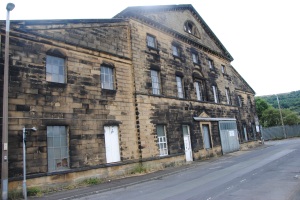
This is the place where the Luddites were first brought for questioning, they were held in the cellars then brought out one by one by the military and questioned by Joseph Radcliffe . Joseph Radcliffe had got all the information he needed from Benjamin Walker so was just trying to fill in the gaps with the questioning . The Luddites were tried at the York assizes, the jury were made from the rich and the landed gentry – including Joseph Radcliffe of course, who had obtained the information for the prosecution counsel (no bias there then) . Mellor, Thorpe and Smith, who were all in their early twenties, never confessed to the murder of William Horsefall , but the evidence given by Benjamin Walker was enough to convict them . It was of course a Show trial – it was the authorities showing the common man who was in charge. Mellor , Smith and Thorpe were executed on January 8th 1813, and their bodies were sent for dissection, a week later on Saturday the 16th of January, 14 more Luddites were executed in small groups – one group began to sing a hymn as they stood on the scaffold ” Behold the saviour of mankind ” . The bodies of these men were given back to their families for burial. Plenty more people were awaiting trial but the judiciary decided that the lesson had been learned, so adjourned the cases indefinitely to be held on file. As a result of the executions fourteen wives were made widows, fifty seven children became fatherless, and eight were turned upon the world helpless. The judge for these fourteen was Baron Thompson. The judge for Mellor, Thorpe, and Smith was Justice Le Blanc.

Here is an old postcard of Ottiwells house

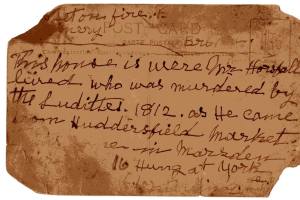


Great post.
I’d never actually read the grim details of William Horsefall’s death until now.
Can you imagine being the person who found the gun 50 odd years later? The gun that killed William Horsefall? Awesome stuff.
I’m surprised I never commented on this.
Just gave it another read through – and although I was familiar of the topic, the details make it even more intriguing. Would like to know what happened to that pistol after it was discovered as it went missing again in 1892, when the new “owner” (a landlord of a hotel) died.
Must still be kicking about.
I believe only the corroded metalwork of the pistol remained, so when people lost interest in viewing it, it was probably put away somewhere, then probably discarded in a clearout